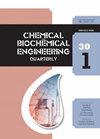黑参提取物的抗氧化能力和缓蚀性能
IF 0.9
4区 生物学
Q4 BIOTECHNOLOGY & APPLIED MICROBIOLOGY
引用次数: 0
摘要
采用扫描速率为100 mV s−1,在0 V ~ 800 mV电位范围内记录的循环伏安图测定了黑参提取物中抗氧化剂含量(抗氧化能力)。提取物的抗氧化能力为4.06 mg GAE g−1 fw(每克鲜重提取物的没食子酸当量mg)。采用动电位极化法和电化学阻抗谱法研究了黑参提取物在3% NaCl溶液中对铝、铜和青铜的缓蚀效果。极化数据表明,萃取物为混合型缓蚀剂,其缓蚀过程为萃取物分子在金属表面的自然物理吸附(Δ G≈-16 kJ mol -1),遵循Freundlich等温线。阻抗谱研究表明,提取物浓度的增加降低了双层电容,增加了电荷转移电阻。当萃取物浓度为1.0 g L -1时,Cu: ~ 57%, CuSn14: ~ 74%, Al: ~ 58%,抑制率最高。本文章由计算机程序翻译,如有差异,请以英文原文为准。
Antioxidant Capacity and Corrosion Inhibition Efficiency of Sambucus nigra L. Extract
The cyclic voltammogram recorded in the potential range between 0 V and 800 mV with scan rate of 100 mV s −1 was used to determine the measure of antioxidants content (antioxidant capacity) present in Sambucus nigra L. extract. The antioxidant capacity of the extract was 4.06 mg GAE g −1 fw (mg of gallic acid equivalents per gram of fresh weight of the extract). The corrosion inhibition efficiency of Sambucus nigra L. extract on aluminium, copper, and bronze in 3 % NaCl solution was studied by potentiodynamic polarization and electrochemical impedance spectroscopy. Polarization data showed that extract acted as a mixed-type inhibitor, that the corrosion inhibition process was spontaneous physical adsorption (Δ G ≈ –16 kJ mol –1 ) of the extract molecules on metals surfaces and followed Freundlich isotherm. Impedance spectroscopy studies revealed that increasing the concentration of extract reduced the double-layer capacitance and increased the charge transfer resistance. The highest inhibition efficiencies (Cu: ~ 57 %, CuSn14: ~74 % and Al: ~58 %) were achieved for an extract concentration of 1.0 g L –1 .
求助全文
通过发布文献求助,成功后即可免费获取论文全文。
去求助
来源期刊
CiteScore
2.70
自引率
6.70%
发文量
23
审稿时长
>12 weeks
期刊介绍:
The journal provides an international forum for presentation of original papers, reviews and discussions on the latest developments in chemical and biochemical engineering. The scope of the journal is wide and no limitation except relevance to chemical and biochemical engineering is required.
The criteria for the acceptance of papers are originality, quality of work and clarity of style. All papers are subject to reviewing by at least two international experts (blind peer review).
The language of the journal is English. Final versions of the manuscripts are subject to metric (SI units and IUPAC recommendations) and English language reviewing.
Editor and Editorial board make the final decision about acceptance of a manuscript.
Page charges are excluded.

 求助内容:
求助内容: 应助结果提醒方式:
应助结果提醒方式:


